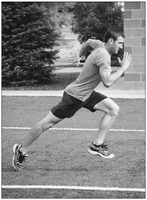Speed
Athletes who can move faster than their opponents have an advantage. For example, a faster athlete may be able to get to a ball more quickly than a competitor or may even outrun a pursuer. For this reason, athletes in most sports value speed highly. Speed is often measured by using linear (straight-line) sprinting over a distance between 40 and 100 yards (37–91 m). However, it is important to remember that in most sports, athletes rarely sprint more than 30 yards (27 m) in a straight line before they must make some type of directional change. Unless an athlete is a 100-meter sprinter, focusing a great deal of time and attention on straight-ahead speed may not result in optimum performance. On the other hand, since most sports require acceleration from a static state or when transitioning between movements, straight-line speed is still a valuable asset that athletes should focus on when testing and training for sports.
Linear sprinting is a physical skill that most people have performed since their second year of life with some level of proficiency.For decades, many coaches believed that linear speed was mostly related to genetics and could not be significantly improved by training. However, appropriate training does improve running speed, even at the elite level. The combination of stride rate (the number of strides per unit of time) and stride length (the distance covered in a single stride) primarily determines linear speed. So, athletes can improve linear speed by increasing stride rate while maintaining stride length, increasing stride length while maintaining stride rate, or doing a combination of both.
Most sports, with the exception of track-and-field sprinting, involve short sprints (Acceleration is the rate of change in velocity, so this phase of sprinting is critical for changing directions as rapidly and efficiently as possible.
Optimal technique for linear sprinting in the acceleration phase involves four factors that maximize stride length and frequency:
- The body should have a pronounced forward lean that results in a lower center of mass. Consequently, momentum in a linear direction increases. This position initiates foot contact with the ground under or slightly behind the center of mass, reducing forces that cause an athlete to slow down or brake.
- When pushing off the ground during the propulsion phase, the foot touches the ground in a cocked position, with the ankle flexed upward at approximately 90 degrees (dorsiflexion) and the toes pointed back toward the shin. Once the foot makes contact with the ground, the athlete extends the hip, knee, and ankle simultaneously with as much force as possible (see figure 1.1). This movement is known as triple extension.
- During the recovery phase, the ankle of the free leg should be dorsiflexed while the knee and hip are bent, or flexed. This allows the foot to pass directly under the buttocks and a more rapid turnover at the hip.
- The athlete should make certain to initiate arm swing at the shoulder with the elbow flexed to 90 degrees. He should work on swinging the arm forcefully backward to let the body’s stored elastic energy and stretch reflex provide much of the arm’s forward propulsion.

Figure 1.1 Proper technique for straight ahead sprinting.
In the propulsion phase, the power output and rate of force development of the muscles that make up the hip extensors and the quadriceps muscles contribute to both stride length and frequency. In the recovery phase of the sprint, the hip flexor muscles (located on the front side of the hip) and the hamstring muscles (located on the backside of the upper thigh) are the major contributors to stride frequency. The strength and power of the hip flexors are important factors in rotating the hip quickly from an extended position to a flexed position in preparation for subsequent foot contact.
The hamstrings have an important role as a multijoint muscle group. Because the hamstring muscles cross over both the hip and the knee, they are responsible for slowing down, or decelerating, the lower leg during the recovery phase in preparation for contact with the ground. At the same time, they also immediately transition to help the hip extend for the propulsion phase of sprinting.
In contrast to straight-ahead sprinting, during backpedaling, the hamstring muscles are less active and the quadriceps muscles are more active. Lateral movements involve more activity from the hip abductors than forward sprinting does. These muscles take the leg away from the body. Therefore, programs focused on improving agility performance should pay particular attention to developing strength in the hip flexors, the hamstrings, and the muscles that surround the hips.
Another important factor contributing to optimum speed is joint flexibility. If the hamstrings are excessively tight, athletes may not be able to bring the knee up as high during the recovery phase of sprinting, hindering hip flexion and speed. Furthermore, tight hip flexors may restrict the ability to extend the hip through the full necessary range of motion, thereby reducing power output during the triple-extension phase of propulsion. Proper flexibility of the involved joints contributes to movements that are more fluid and coordinated, resulting in longer and faster strides and greater speed.